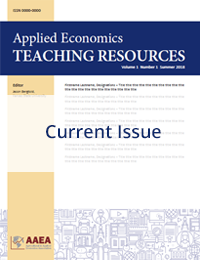Teaching and Educational Methods
Teaching about Diversity and Racism in Food Systems: An Example for Agricultural Economics and Related Departments
Jane Kolodinsky(a), Daniel Tobin(a)
(a)University of Vermont
JEL Codes: A22, D63, I3, J15
Keywords: Agriculture, food systems, race, racism, undergraduate education
First Published Online: December 30, 2020
Volume 2, Issue 6
View Full Article (PDF) | Request Teaching Notes/Supplemental Materials
Abstract
This paper presents curriculum and metrics for a course titled U.S. Food, Social Equity & Development, taught since 2015. The course meets a race and racism diversity course requirement at the University of Vermont. Departments affiliated with AAEA have an obligation to teach and inform our students about racism in the food system: individual and systemic, intended and unintended, institutional and structural. This has been reinforced by the June 3, 2020, AAEA statement condemning racially motivated acts of violence, police brutality, and overreach of military action, and committed to pledging positive action toward diversity, equity, and inclusion. By understanding the opportunity associated with our obligation, we will graduate future professionals and scholars who understand the importance of including issues of racism in their research; future food producers who will better recognize and attend to the issue of racism; and future consumers who understand how their consumption decisions impact racism.
References
Agricultural and Applied Economics Association. n.d. “Agricultural and Applied Economics Departments.” Retrieved from https://www.aaea.org/about-aaea/agricultural-and-applied-economics-departments.
Agricultural and Applied Economics Association Executive Board. 2020. “A Message from the AAEA Executive Board.” AAEA Blog. http://blog.aaea.org/2020/06/a-message-from-aaea-executive-board.html?utm_source=feedburner&utm_medium=feed&utm_campaign=Feed%3A+AAEABlog+%28AAEA+Blog%29.
Alberta Civil Liberties Research Centre. n.d. “Forms of Racism.” http://www.aclrc.com/forms-of-racism.
Center for Applied Special Technology. n.d.a. “Course Design.” http://udloncampus.cast.org/page/planning_landing.
Center for Applied Special Technology. n.d.b. “Universal Design for Learning: UDL on Campus.” http://udloncampus.cast.org/home.
Crenshaw, K.W. 1989. "Demarginalizing the Intersection of Race and Sex: A Black Feminist Critique of Antidiscrimination Doctrine, Feminist Theory, and Antiracist Politics." University of Chicago Legal Forum 8: 129-167.
Dunbar-Ortiz, R. 2015. An Indigenous Peoples’ History of the United States. Boston MA: Beacon Press.
Figueora, M., and L. Penniman. 2020. “Land Access for Beginning and Disadvantaged Farmers. Green.” Green New Deal Policy Series: Food and Agriculture, Data for Progress. https://www.dataforprogress.org/memos/land-access-for-beginning-disadvantaged-farmers.
Gilbert, J., G. Sharp, M. Sindy Felin, and M. Felin. 2002. “The Loss and Persistence of Black-Owned Farms and Farmland: A Review of the Research Literature and Its Implications.” Journal of Rural Social Sciences 18(2):Article 1.
Hinson, W.R., and E. Robinson. 2008. “‘We Didn’t Get Nothing’: The Plight of Black Farmers.” Journal of African American Studies 12(3):283–302. https://doi.org/10.1007/s12111-008-9046-5.
Institute of Medicine, and Natiional Research Council. 2015. A Frame for Assessing the Effects of the Food System. Washington, DC: The National Academies Press.
Inter-Institutional Network for Food, Agriculture, and Sustainability. 2018. “INFAS Supplement to the Association of Public and Land-Grant Universities.’ The Challenge of Change: Harnessing University Discovery, Engagement, and Learning to Achieve Food and Nutrition Security.” Davis CA. https://asi.ucdavis.edu/programs/infas/a-deeper-challenge-of-change-the-role-of-land-grant-universities-in-assessing-and-ending-structural-racism-in-the-us-food-system.
Jakubek, J., and S.D. Wood. 2017. "Emancipatory Empiricism: The Rural Sociology of W.E.B. Du Bois. Sociology of Race and Ethnicity 4(1): 14-34.
Jayaraman, S. 2013. Behind the Kitchen Door. Ithaca NY: ILR Press.
Kendi, I.X. 2019. How to Be an Antiracist. New York: One World.
Miraftab, F. 2016. Global Heartland: Displaced Labor, Transnational Lives, and Local Placemaking. Bloomington: Indiana University Press.
Naples, N.A. 2003. Feminism and Method: Ethnography Discourse Analysis and Activism. Abingdon: Routledge.
National Research Council. 1995. “Profiles of the Land Grant Colleges of Agriculture.” In Colleges of Agriculture at the Land Grant Universities: A Profile, p. 83–104. The National Academies Press. https://www.nap.edu/catalog/4980/colleges-of-agriculture-at-the-land-grant-universitiesa-profile.Odoms-Young, A., and M.A. Bruce. 2018. “Examining the Impact of Structural Racism on Food Insecurity.” Family & Community Health 41:S3–S6. https://doi.org/10.1097/FCH.0000000000000183.
Peña, O. 2015. “Diversity Education at Land-Grant Universities from the Perspective of a Female Student of Color.” Journal of Agriculture, Food Systems, and Community Development, August, 1–4. https://doi.org/10.5304/jafscd.2015.054.020.
Perea, J.F. 2011. “The Echoes of Slavery: Recognizing the Racist Origins of the Agricultural and Domestic Worker Exclusion from the National Labor Relations Act.” Ohio State Law Journal 95:96–138.
Petersen, R., L. Pan, and H.M. Blanck. 2019. “Racial and Ethnic Disparities in Adult Obesity in the United States: CDC’s Tracking
to Inform State and Local Action.” Preventing Chronic Disease 16:180579. Pfeffer, M. 1983. “Social Origins of Three Systems of Farm Production in the United States.” Rural Sociology 48(4):540–562. Quisumbing, A. R., R. Meinzen-Dick, T.L. Raney, A. Croppenstedt, J.A. Behrman, and A. Peterman. 2014. Gender in Agriculture: Closing the Knowledge Gap. Dordrecht: Springer Science & Business.
Articles in this issue
Evaluation of Learning Outcomes from Participation in a Student-Managed Commodity Investment Fund
A. Ford Ramsey and Olga Isengildina-Massa
Teaching about Diversity and Racism in Food Systems: An Example for Agricultural Economics and Related Departments
Jane Kolodinsky, Daniel Tobin
Educating the Next Generation of Interdisciplinary Researchers to Tackle Global Sustainability Challenges: A Graduate CourseÂ
Thomas W. Hertel
Flipping Together: A Collaborative Approach to a Flipped Class
Kasee L. Smith, Aaron J. Johnson, and Dain R. Johnson
Consolidation in the Farm Credit System: The Case of AgCountry and United
Erik D Hanson


